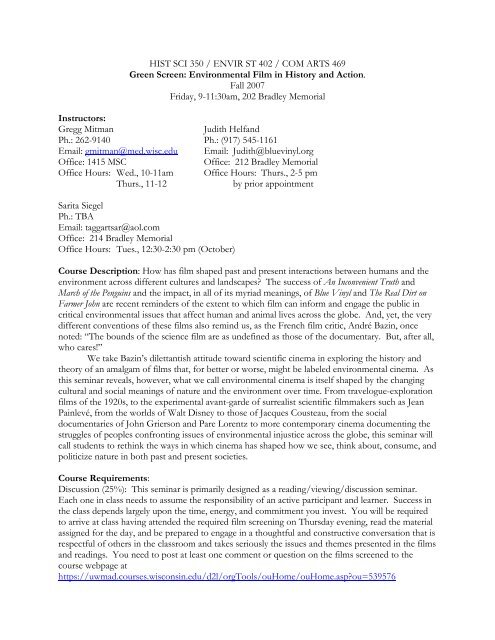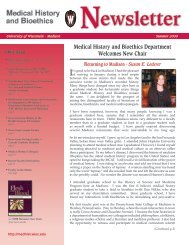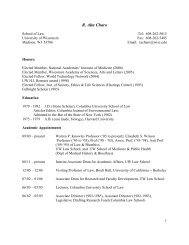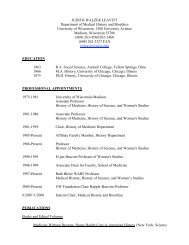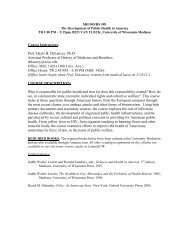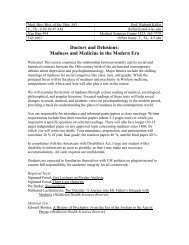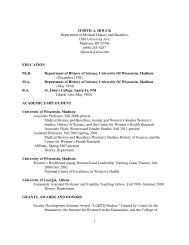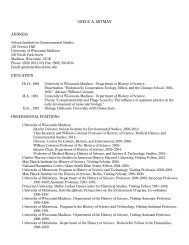Syllabus - Medical History & Bioethics
Syllabus - Medical History & Bioethics
Syllabus - Medical History & Bioethics
You also want an ePaper? Increase the reach of your titles
YUMPU automatically turns print PDFs into web optimized ePapers that Google loves.
HIST SCI 350 / ENVIR ST 402 / COM ARTS 469Green Screen: Environmental Film in <strong>History</strong> and Action.Fall 2007Friday, 9-11:30am, 202 Bradley MemorialInstructors:Gregg MitmanJudith HelfandPh.: 262-9140 Ph.: (917) 545-1161Email: gmitman@med.wisc.edu Email: Judith@bluevinyl.orgOffice: 1415 MSCOffice: 212 Bradley MemorialOffice Hours: Wed., 10-11am Office Hours: Thurs., 2-5 pmThurs., 11-12by prior appointmentSarita SiegelPh.: TBAEmail: taggartsar@aol.comOffice: 214 Bradley MemorialOffice Hours: Tues., 12:30-2:30 pm (October)Course Description: How has film shaped past and present interactions between humans and theenvironment across different cultures and landscapes? The success of An Inconvenient Truth andMarch of the Penguins and the impact, in all of its myriad meanings, of Blue Vinyl and The Real Dirt onFarmer John are recent reminders of the extent to which film can inform and engage the public incritical environmental issues that affect human and animal lives across the globe. And, yet, the verydifferent conventions of these films also remind us, as the French film critic, André Bazin, oncenoted: “The bounds of the science film are as undefined as those of the documentary. But, after all,who cares!”We take Bazin’s dilettantish attitude toward scientific cinema in exploring the history andtheory of an amalgam of films that, for better or worse, might be labeled environmental cinema. Asthis seminar reveals, however, what we call environmental cinema is itself shaped by the changingcultural and social meanings of nature and the environment over time. From travelogue-explorationfilms of the 1920s, to the experimental avant-garde of surrealist scientific filmmakers such as JeanPainlevé, from the worlds of Walt Disney to those of Jacques Cousteau, from the socialdocumentaries of John Grierson and Pare Lorentz to more contemporary cinema documenting thestruggles of peoples confronting issues of environmental injustice across the globe, this seminar willcall students to rethink the ways in which cinema has shaped how we see, think about, consume, andpoliticize nature in both past and present societies.Course Requirements:Discussion (25%): This seminar is primarily designed as a reading/viewing/discussion seminar.Each one in class needs to assume the responsibility of an active participant and learner. Success inthe class depends largely upon the time, energy, and commitment you invest. You will be requiredto arrive at class having attended the required film screening on Thursday evening, read the materialassigned for the day, and be prepared to engage in a thoughtful and constructive conversation that isrespectful of others in the classroom and takes seriously the issues and themes presented in the filmsand readings. You need to post at least one comment or question on the films screened to thecourse webpage athttps://uwmad.courses.wisconsin.edu/d2l/orgTools/ouHome/ouHome.asp?ou=539576
efore the start of the class session in which the films will be discussed.If any problem arises, either academic or personal, that might jeopardize your performance in thecourse, you must try to inform me of the problem at the next available office hour, or by leaving amessage with the Department of <strong>Medical</strong> <strong>History</strong> and <strong>Bioethics</strong> (262-1460).In compliance with the Americans with Disabilities Act, I urge any student in this course with adisability to inform me as soon as possible, so that I may make any necessary accommodations toensure full participation and facilitate your educational opportunities. All such requests areconfidential.Students are expected to familiarize themselves with the UW policies on plagiarism and to assumeresponsibility for honesty in all course work.Film Review (15%): Choose a film, either screened in class, or one approved in consultation withus, and write a 1,000 word review essay that discusses how the film was received during its time.Can you provide evidence of how the film effected change, either in people’s response to the film orin their actions. What was the venue and context in which the film was screened? Due, October 12Film Festival (20%): You are required to attend the film festival, Tales From Planet Earth(http://www.nelson.wisc.edu/tales) from Nov. 2-4, and see at least five films. We will have a signup sheet at each of the screenings for you to sign. In addition, you are to watch one of the followingfilms at the festival: Return of Navajo Boy; The Silent Enemy; or Ten Canoes. Write a 1,000 word essaythat discusses the film in relation to the material we read and discussed on the ethical and politicalissues involved in the filming and representation of indigenous peoples. Due, November 9.Research Paper (40%): You are to choose a recent or historical environmental film and write a 15-20 page essay analyzing its myriad impacts—economic, cultural, political, and social. Who made thefilm and why? In what context was the film shown and seen? What was its audience? How was thefilm received by critics and the public? Did the film alter public attitudes toward nature or theenvironment in significant ways? What kinds of evidence can you draw upon for measuring a film’simpact? These are the kinds of questions you will be pursuing in this essay. Due, December 14.Required Readings:The following required books are available at the University Bookstore:Gregg Mitman, Reel Nature: America’s Romance with Wildlife on Film (Cambridge:Harvard University Press, 1999).Fatimah Tobing Rony, The Third Eye: Race, Cinema, and Ethnographic Film (Durham: DukeUniversity Press, 1996).A course packet (CP) is also available in the Department of <strong>History</strong> of Science, 7143 Social ScienceBuilding for purchase. The articles will also be placed on reserve at Helen C. White College Library.
People9/7 A Place for StoriesWilliam Cronon, "A Place for Stories: Nature, <strong>History</strong>, and Narrative," Journal of American<strong>History</strong> 78 (1992): 1347-1376. CP, 1-30.William Stott, Documentary Expression and Thirties America (New York: OxfordUniversity Press, 1973), pp. 5-25. CP, 31-42.Robert Coles, The Call of Stories: Teaching and the Moral Imagination (Boston: HoughtonMifflin, 1989), pp. 1-30. CP, 43-58.Finis Dunaway, Natural Visions: The Power of Images in American Environmental Reform(Chicago: University of Chicago Press, 2005), pp. 60-86. CP, 59-76.9/14 Capturing PlaceJohn Grierson, “Flaherty” and “First Principles of Documentary,” in Grierson onDocumentary, edited and compiled by Forsyth Hardy (London: Faber and Faber,1966), pp. 139-156. CP, 77-88.Paul Rotha, Documentary Film (London: Faber and Faber, 1936), pp. 115-120. CP,89-94.Fatimah Tobing Rony, The Third Eye, pp. 99-126.Brian Winston, “Documentary: How the Myth Was Deconstructed,” Wide Angle 21(March 1999): 70-86. CP, 95-110.9/21 Imagining IndiansShepard Krech, III, The Ecological Indian: Myth and <strong>History</strong> (New York: W. W.Norton, 1999), pp. 15-28. CP, 111-122.Mick Gidley, “”From the Hopi Snake Dance to The Ten Commandments: EdwardCurtis as Filmmaker,” Studies in Visual Communication 8 (1982): 70-79. CP, 123-132.Gregg Mitman, Reel Nature: America’s Romance with Wildlife on Film (Cambridge:Harvard University Press, 1999), 26-58.Fatimah Tobing Rony, “Victor Masayeevsa, Jr., and the Politics of Imagining Indians,”Film Quarterly 48 (1994-1995): 20-33. CP, 133-148.Faye Ginsburg, “Indigenous Media: Faustian Contract or Global Village?,” CulturalAnthropology 6 (1991): 92-112. CP, 149-170.See, also, http://www.onf.ca9/28 First Person ToxicBarbara Allen, “Telling Stories about the Environment,” in Uneasy Alchemy:Citizens and Experts in Louisiana’s Chemical Corridor Disputes (Cambridge: MIT
Gregg Mitman, “Hunting with the Camera,” in Reel Nature: America’s Romancewith Wildlife on Film (Cambridge: Harvard University Press, 1999), pp. 5-25.Griselda Pollack, “Empire, identity, and place: masculinities in Greystoke: the legendof Tarzan,” in Me Jane: Masculinity, Movies and Women (New York: St. Martin’sPress, 1995), pp. 128-147. Available on course website.Fatimah Tobing Rony, “King Kong and the Monster in Ethnographic Cinema,” inThe Third Eye: Race, Cinema, and Ethnographic Spectacle (Durham: DukeUniversity Press, 1996), pp. 157-191.10/26 The Media of ConservationDavid Ingram, Green Screen: Environmentalism and Hollywood Cinema (Exeter:University of Exeter Press, 2000), pp. 1-10, 73-87, 119-136. CP, 465-494.Gregg Mitman, “Pachyderm Personalities,” in Thinking With Animals: NewPespectives on Anthropomorphism, edited by Lorraine Daston and Gregg Mitman(New York: Columbia University Press, 2005), pp. 175-195. CP, 495-506.Charles Siebert, “Are We Driving Elephants Crazy?” New York Times Magazine (8October 2006): 42-48, 64, 71, 72. CP, 507-514.Tom Veltre, “The Slums of the Global Village,” BBC Wildlife (May 1990): 328-329.CP, 515-516.Stephen Mills, “Pocket Tigers,” Times Literary Supplement (21 February 1997): 6.CP, 517-518.Richard Brock, “FFC Conservation Filmmaker of the Year Award,” 4 pp. CP, 519-522.Chris Palmer, “Successful Environmental Filmmaking,” 27 March 2004, 4 pp. CP,523-526.11/2 NO CLASSHybrid Landscapes11/9 Great White HuntingDonna Haraway, “Teddy Bear Patriarchy: Taxidermy in the Garden of Eden, NewYork City, 1908-1936,” Social Text 11 (1984-85): 20-64. CP, 527-574.Fatimah Tobing Rony, The Third Eye, pp. 2-20, 45-73.John C. Phillips and Harold J. Coolidge, The First Five Years: The AmericanCommittee for International Wildlife Protection (December 1934), pp. 2-15. CP, 575-582.11/16 Invasive Species
Mike Davis, “Maneaters of the Sierra Madre,” in Ecology of Fear: Los Angeles andthe Imagination of Disaster (New York: Metropolitan Books, 1998), 197-271. CP,583-626.Lesley Head and Pat Muir, “Suburban Life and the Boundaries of Nature: Resilienceand Rupture in Australian Backyard Gardens,” Transactions of the Institute ofBritish Geographers 31 (2006): 505-524. CP, 627-646.Jake Kosek, “Smokey Bear is a White Racist Pig,” in Understories: The Political Lifeof Forests in Northern New Mexico (Durham: Duke University Press, 2006), pp.183-227. CP, 647-676.Visit the website, http://www.frogwatch.org.au/canetoads/default.cfm11/23 NO CLASS11/30 From the Factory to the FarmVisit the website and resource links for Homecoming at:http://www.pbs.org/itvs/homecoming/home.htmlDavid Walsh, “Interview with Travis Wilkerson, director of An Injury to One,”Toronto International Film Festival 2002. CP, 677-682.Richard White, “`Are You an Environmentalist or Do You Work for a Living?’: Work andNature,” in Uncommon Ground: Toward Reinventing Nature (New York: W. W. Norton,1995), pp. 171-185, 499-501. CP, 683-694.12/7 Unnatural DisasterEric Klinenberg, Heat Wave: A Social Autopsy of Disaster in Chicago (Chicago: Universityof Chicago Press, 2002), pp. 14-36, 79-128. CP, 695-740.Orin Williams, “Food and Justice: The Critical Link to Healthy Communities,” inPower, Justice, and the Environment, edited by David Naguib Pellow and Rober J.Brulle (Cambridge: MIT Press, 2005), pp. 117-130. CP, 741-748.12/14 Wrap-UpSCREENINGSThursdays, 7:00-9:30 pm (Screenings in September will be held in Rm. 175, Science Hall)9/6 The Grapes of Wrath (1940, 129 min.)The River (1937, 32 min.)Let My People Live (1938, 13 min.)9/13 The Man of Aran (1934, 76 min.)How the Myth Was Made (1978, 58 min.)
9/20 PSA of Ecological IndianIn the Land of the War Canoes (1914, 43 min.)Intrepid Shadows (1966, 18 min.)Imagining Indians (1992, 60 min.)9/27 Helfand Screening – Sundance Cinemas, Hilldale MallBlue Vinyl (2002, 98 min.), with selections from the Peabody award-winning prequel AHealthy Baby Girl10/4 Comandon footageEdison’s Electrocuting an Elephant (1903)Coolidge footageWinged Migration (2001, 89 min.)10/11 The Seahorse (1934, 15 min.)Beaver Valley (1950, 32 min.)Siegel Screening – Madison Museum of Contemporary Art, 227 State StreetThe Beloved (1998, 15 min.)The Disenchanted Forest (2001, 52 min.)10/18 Burden East Indian ExpeditionKing KongMiss Jane Goodall and the Wild Chimpanzees10/25 The Family that Lives with Elephants (1976, 30 min.)Africa’s Elephant Kingdom (1997, 40 min.)Ocean Oasis (2003, 75 min.)11/8 Coolidge material11/15 Cane Toads (1988, 47 min.)WWII pest or Smokey the Bear film11/29 Homecoming (1999, 56 min.)An Injury to One (2002, 53 min.)12/6 Weather ChannelHelfand’s rough cut of Heat Wave12/13 Final projects of production class


